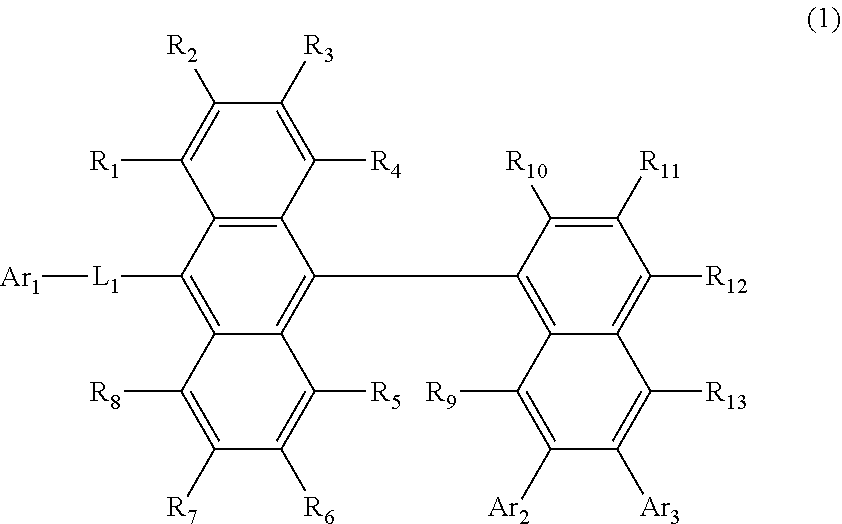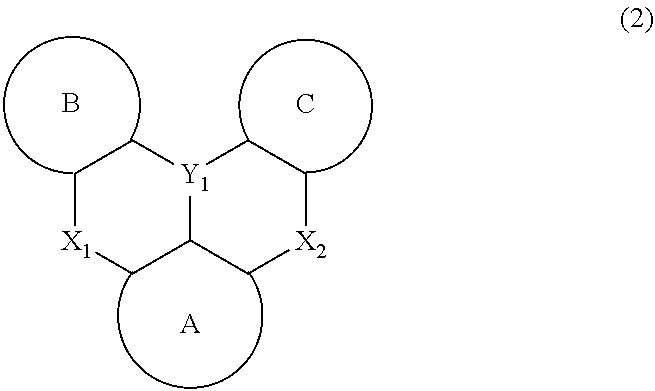Plurality of light-emitting material and organic electroluminescent device comprising the same
- Summary
- Abstract
- Description
- Claims
- Application Information
AI Technical Summary
Benefits of technology
Problems solved by technology
Method used
Image
Examples
example 1
on of Compound H1-1
[0086]
[0087]In a flask, compound 1-1 (10 g, 21.7 mmol), phenylboronic acid (3.2 g, 26.1 mmol), PdCl2(Amphos)2 (0.77 g, 1.1 mmol), Na2CO3 (4.62 g, 43.6 mmol), toluene 150 mL, distilled water 50 mL, and Aliquat336 (0.44 g, 1.1 mmol) were added and stirred under reflux for 30 minutes. After cooling to room temperature, distilled water was added thereto. An organic layer was extracted with dichloromethane and dried by magnesium sulfate. The organic layer was distilled under reduced pressure and separated by column chromatography to obtain compound H1-1 (9 g, 90.9%).
MWM.P.H1-1456.59242° C.
example 2
on of Compound H1-6
[0088]
[0089]In a flask, compound 1-1 (10 g, 21.7 mmol), compound 2-1 (6.5 g, 26.1 mmol), PdCl2(Amphos)2 (0.49 g, 0.7 mmol), Na2CO3 (6.9 g, 65.4 mmol), toluene 200 mL, distilled water 65 mL, and Aliquat336 (0.5 mL, 1.1 mmol) were added and stirred at 130° C. for 3 hours.
[0090]After cooling to room temperature, distilled water was added thereto. An organic layer was extracted with dichloromethane and dried by magnesium sulfate. The organic layer was distilled under reduced pressure and separated by column chromatography to obtain compound H1-6 (9.2 g, 72.4%).
example 3
on of Compound H1-7
[0091]
[0092]In a flask, compound 1-1 (10 g, 21.7 mmol), compound 3-1 (6.5 g, 26.1 mmol), PdCl2(Amphos)2 (0.49 g, 0.7 mmol), Na2CO3 (6.9 g, 65.4 mmol), toluene 200 mL, distilled water 65 mL, and Aliquat336 (0.5 mL, 1.1 mmol) were added and stirred at 130° C. for 3 hours. After cooling to room temperature, distilled water was added thereto. An organic layer was extracted with dichloromethane and dried by magnesium sulfate. The organic layer was distilled under reduced pressure and separated by column chromatography to obtain compound H1-7 (9.9 g, 77.9%).
PUM
| Property | Measurement | Unit |
|---|---|---|
| Purity | aaaaa | aaaaa |
Abstract
Description
Claims
Application Information
 Login to View More
Login to View More - R&D Engineer
- R&D Manager
- IP Professional
- Industry Leading Data Capabilities
- Powerful AI technology
- Patent DNA Extraction
Browse by: Latest US Patents, China's latest patents, Technical Efficacy Thesaurus, Application Domain, Technology Topic, Popular Technical Reports.
© 2024 PatSnap. All rights reserved.Legal|Privacy policy|Modern Slavery Act Transparency Statement|Sitemap|About US| Contact US: help@patsnap.com










